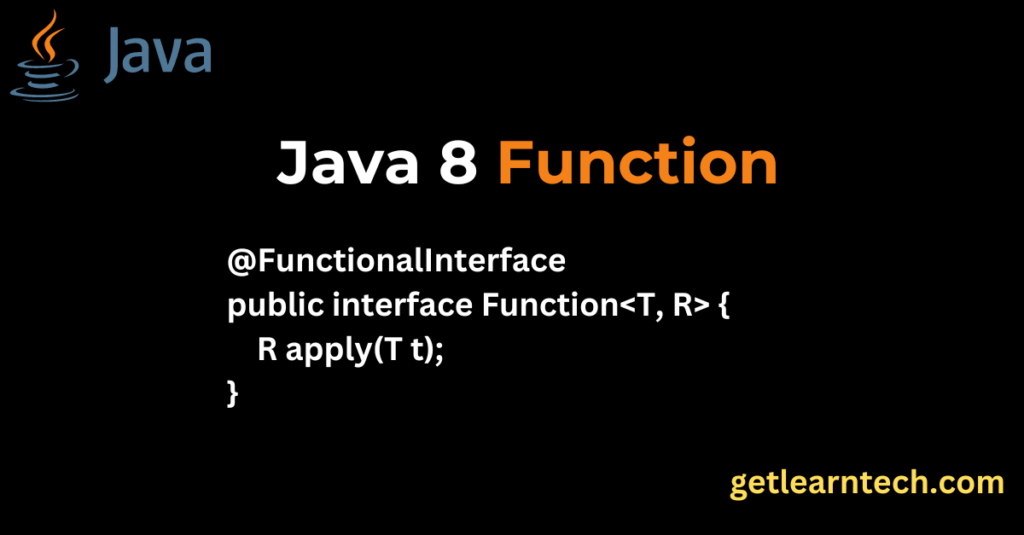
Table of Contents
Introduction
Java 8 introduced the Function interface as part of its functional programming enhancements, allowing developers to write more concise and expressive code. In this article, we will delve into the Java 8 Function interface, understand its purpose, and see how it can streamline coding tasks using lambda expressions.
If you are preparing for Java 8 interviews then checkout this.
Understanding the function interface
The Function interface in Java 8 is a functional interface that represents a function that accepts one argument and produces a result. It is part of the java.util.function package and contains a single abstract method called apply().
How Function Java 8 Interface works
The apply() method of the Function interface takes an input argument of a certain type and returns a result of another type. This allows developers to define transformations or mappings from one type to another in a clear and concise manner.
Example of Using Function Interface :
Let’s consider a simple example where we use the Function interface to square a number.
In this example, we define a Function called square that takes an integer as input and returns its square as output. By using the apply() method, we can easily calculate the square of a number using a lambda expression.
import java.util.function.Function;
public class FunctionExample {
public static void main(String[] args) {
Function<Integer, Integer> square = n -> n * n;
System.out.println(square.apply(4)); // Output: 16
}
}
Example of Java 8 Function interface with chaining :
In this example:
- We define two functions:
incrementByOneandsquareResult. - We chain these functions together using the
andThenmethod, which executes the current function followed by another function. - The
incrementAndSquarefunction first increments the input by 1 and then squares the result. - When we apply this chained function to the number 5, it first increments by 1 (resulting in 6) and then squares the result (resulting in 36).
import java.util.function.Function;
public class FunctionChainingExample {
public static void main(String[] args) {
// Define the first function: increment by 1
Function<Integer, Integer> incrementByOne = num -> num + 1;
// Define the second function: square the result
Function<Integer, Integer> squareResult = num -> num * num;
// Chain the functions together: increment by 1 and then square the result
Function<Integer, Integer> incrementAndSquare = incrementByOne.andThen(squareResult);
// Test the chained function
int result = incrementAndSquare.apply(5);
System.out.println("Result: " + result); // Output: Result: 36
}
}
Example of Function Interface with Java 8 Streams :
In this example, we have a list of integers numbers from 1 to 5. We use the map() function to square each number in the list. The lambda expression n -> n * n is applied to each element in the stream, squaring it. Finally, we collect the squared numbers into a new list using collect(Collectors.toList()).
import java.util.Arrays;
import java.util.List;
import java.util.stream.Collectors;
public class FunctionStreamExample {
public static void main(String[] args) {
// Create a list of integers from 1 to 5
List<Integer> numbers = Arrays.asList(1, 2, 3, 4, 5);
// Use the map() function to square each number in the list
List<Integer> squaredNumbers = numbers.stream()
.map(n -> n * n) // Lambda expression to square each number
.collect(Collectors.toList()); // Collect squared numbers into a new list
// Print the squared numbers
System.out.println("Squared numbers: " + squaredNumbers);
}
}
This example demonstrates how a function (squaring each number) can be applied to elements in a stream using the map() function in Java 8 streams.
Key Features of Java 8 Function Interface:
- Lambda Expressions: Functions in Java 8 can be defined using lambda expressions, enabling concise and expressive code.
- Composition: Functions support composition, allowing developers to combine multiple functions to create more complex behavior.
- Chaining: With the introduction of default methods in interfaces, functions can be chained together seamlessly, promoting code reuse and modularity.
- Method References: Method references provide a shorthand syntax for creating functions, enhancing code readability and maintainability.
Benefits of Using Java 8 Function Interface:
- Code Readability: Function interface with lambda expressions makes code more readable and expressive.
- Reusability: Functions defined using the Function interface can be easily reused in different parts of the code.
- Flexibility: Function interface provides flexibility in defining custom transformations or mappings between different types.
Conclusion
The Function interface in Java 8 is a powerful tool that simplifies coding tasks by allowing developers to define functions that transform input data into output results. By leveraging lambda expressions with the Function interface, developers can write cleaner, more concise code that is easier to understand and maintain. Incorporating the Function interface in Java 8 programming opens up new possibilities for creating efficient and flexible solutions.

